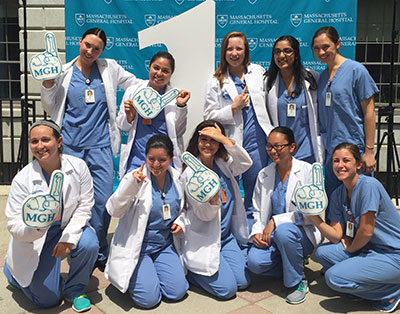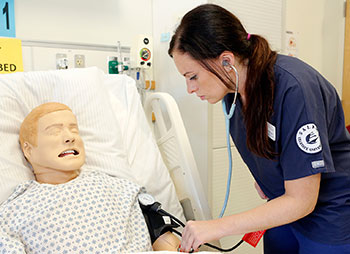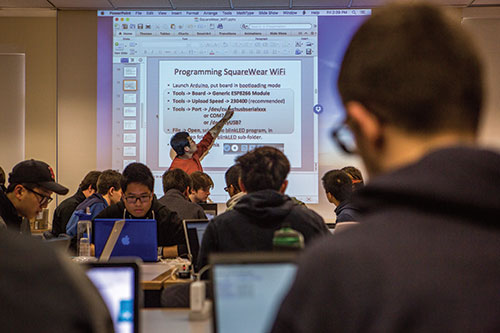

Given Massachusetts’ rising need for more nurses and computer science professionals, a reader might assume that public college and university programs to prepare graduates for these careers would expand to meet demand. In some cases, there is room to grow. Elsewhere, public campuses report that their programs are at or beyond capacity. At the same time, financial pressures on students are slowing their progress toward degree completion.
According to IPEDS data, Massachusetts’ public colleges and universities increased the number of graduates with bachelor of science in nursing (BSN) degrees by 34 percent between 2010 and 2013. They did so primarily by focusing on an incumbent workforce with LPN, ADN or RN degrees, nurses seeking a higher level of education and training to stay abreast of changes in the increasingly complex health care field. Massachusetts has set a goal to increase the number of nurses with BSN degrees from 55 to 66 percent by 2020.
But attaining the goal may prove challenging. Take the University of Massachusetts Boston, for example. It graduates more students with BSNs than any other college or university, public or private, in the state. But its programs are at capacity and unable to grow further, due in part to a stagnating pool of clinical placements.
“All of the universities are competing for the same placement experiences for students,” says Marion Winfrey, associate dean of the College of Nursing and Health Sciences at UMass Boston. “We’re held up because there are not enough placements—and without a placement, there is no getting through the program.”
As profit margins in the health care industry have tightened, pressures to limit or charge for clinical placements have grown—not only in Massachusetts but in other states as well. “You are down the cost of a Medicare reimbursement,” Winfrey explains, “because you can’t do four 15-minute appointments back to back with a student nurse in tow.”
Indeed, clinical placement data from the Massachusetts Centralized Clinical Placement Management System, a web-based program for scheduling and managing clinical education placements, shows that health care organizations in the Commonwealth are beginning to decline a higher percentage of requests for clinical placement than in prior years. While the actual number of placements is holding steady or even on the rise, the data suggest that is because campus nursing programs are working harder and digging deeper to find clinical placements for students—not because more such placements are available.
The University of Massachusetts Lowell has found one solution: its move to offer clinical placements in the summer has helped the University double its nursing program capacity.
Campuses are also using simulation labs and patient manikins to create an alternative clinical placement experience for students. At Salem State University, there is one sim lab with four manikins and two additional manikins in a makeshift lab—serving an undergraduate nursing program of more than 650 students.
Like UMass Boston and Lowell, Salem State’s nursing program is highly competitive and also “at its limits in terms of classroom and science laboratory space,” according to Neal DeChillo, Salem’s Dean of Human Services. In fall 2016, Salem State’s program received 1,165 applications for admission and accepted just 235 students. University staff, also struggling with the issue of clinical placements, are advocating for a higher-quality simulation environment.
“None of our (current) manikins can be used for a sophisticated sim lab experience,” says Salem’s provost, David Silva. Salem nursing staff envision a new sim lab that could serve as a community resource, providing ongoing professional development for nurses at area hospitals and health care centers. For now, they describe themselves as “pretty desperate” in hunting for space.
“We’re working with one of the local high schools to take advantage of space in their chemistry lab for classes, which sends a curious signal to Salem State students who went there,” says Silva, noting that most students would expect to find more advanced facilities on a college campus than at the high school they attended.
UMass Boston’s Winfrey estimates that up to 50 percent of their clinical placements could be replaced by simulation, but only if another problem is addressed: the need to hire computer-savvy nursing faculty with the skills needed to oversee the new high-tech environments.
Two-thirds of the UMass Boston nursing faculty will retire in the next five years; at Salem State, half the faculty will leave. Such a predicament is fairly typical; statewide, the average age of a nursing professor is 55, according to the American Association of College of Nursing. Most nursing instructors are women who earn their Doctorate of Nursing Practice (DPN) degrees relatively late in life, at an average age of 40, having first taken time to work in the clinical field or raise children. UMass Boston is using grant funds to “fast track” students from BSN to DPN degrees; nonetheless, students often scale back to part-time status because of financial pressures.
“I’ve lost students because they are obligated to send money home to family in Haiti, and they need to work more and can’t afford to stay in school,” Winfrey says. She worries that the sheer volume of students makes it difficult to help those who are struggling to cope with multiple demands from family, employers and the academy.
“In our nursing lab we are working at 117% capacity. That is not the way to prevent students from dropping out. You can’t give all your students the help they need at that capacity level.”

In the red-hot Massachusetts technology field, meanwhile, there are 17 jobs for every one graduate with a degree in computer science or IT, according to the Technology Talent Initiative Workforce Plan released by the DHE in 2014. The report found a “critical gap between the number of degrees granted in computer science and information technology at our public institutions and the current and projected growth in jobs requiring those credentials.” The report suggested that degree-granting in these fields would need to double to meet employer demand.
But the reality on the ground suggests that that there are serious challenges to meeting that goal. At several UMass campuses, highly regarded programs to train the next generation of computer science and IT professionals are at capacity and looking for ways to increase the number of students they can serve.
The computer science program at the University of Massachusetts Amherst is ranked 25th by U.S. News and World Report, tied with Duke University and the University of North Carolina at Chapel Hill. In the last few years, however, the number of admits has roughly doubled, and classes are at their limit. “We can’t hire faculty fast enough,” says Jack Wileden, associate dean of student affairs in the new College of Computer Science.
At UMass Lowell, the online information technology program has seen dramatic growth in recent years, leading the university to begin planning for a traditional on-campus day program in IT to accommodate more students. To address the need for more faculty, the University sought and won a contract amendment which allows for the hiring of full-time, non-tenure track lecturers and clinical faculty who are fully focused on teaching and service, rather than research. The benefits are two-fold: they allow the university to improve its retention and graduation rates while also adding faculty positions to high-demand programs.
“We’re letting STEM and health care programs grow disproportionately,” says John Ting, UMass Lowell’s vice provost for enrollment, explaining that the University is striving to meet employer demand in key fields.
Computer science/IT departments are facing some of the same issues that nursing programs are struggling with, plus some unique challenges:
Bridgewater State University has used a National Science Foundation grant to support student success in computer science and other science programs.
“Before, we were losing up to 50 percent of our students across the board, across all demographics,” says John Santore, chair of the computer science department at Bridgewater. “We added support structures for students; overall I’d say our failure rates in the entry-level Computer Science courses have dropped down below 20 percent.”
Could Bridgewater double the number of computer science graduates to meet industry need, as called for in the Technology Talent Initiative Workforce Plan? “No, but we could probably go another 20 percent,” Santore says, noting that the program has seen steady growth in recent years and has just added an eighth full-time professor. “The problem is that Bridgewater has no space.”